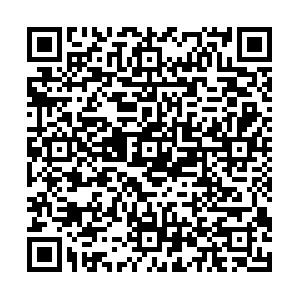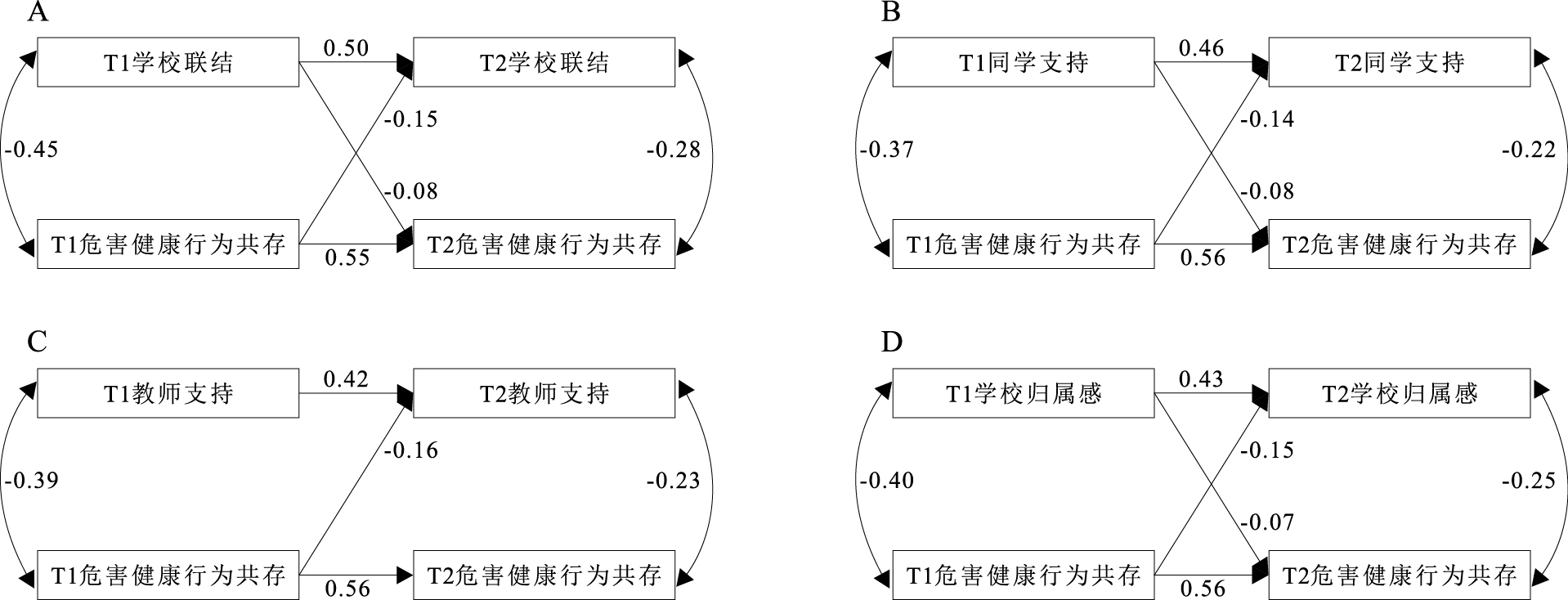A cross-lagged analysis of the co-occurrence of health-risk behaviors and school connectedness among junior high school students
-
摘要:
目的 探讨学校联结与初中生危害健康行为共存的因果关系,为降低初中生危害健康行为的发生提供参考。 方法 采用方便抽样与整群抽样相结合的方法抽取吉首市2所初级中学924名学生作为调查对象,于2023年4月(T1)和10月(T2)采用青少年危害健康行为问卷和学校联结量表进行2次间隔6个月的追踪调查,采用t检验对不同调查时间和不同性别初中生学校联结与危害健康行为共存得分进行比较,采用Mplus 8.3软件进行交叉滞后分析。 结果 初中生在T1和T2调查中学校联结得分分别为(38.86±7.46)(37.87±7.71)分,危害健康行为共存得分分别为(1.64±0.68)(1.83±0.53)分,两次调查得分差异均有统计学意义(t值分别为4.24,-4.14,P值均<0.05)。两次调查学校联结与危害健康行为共存得分相关性均有统计学意义(r=-0.46~-0.33,P值均<0.05)。交叉滞后分析结果显示,T1学校联结负向预测T2危害健康行为共存(β=-0.08),T1危害健康行为共存负向预测T2学校联结(β=-0.15)(P值均<0.05)。 结论 学校联结与初中生危害健康行为共存存在纵向因果关系;提升初中生学校联结水平,有助于降低其危害健康行为共存状况。 Abstract:Objective To explore the causal relationship between adolescent school connectedness and the co-occurrence with health risk behaviors among junior high school students, so as to provide the reference for reducing the occurrence of adolescents' health risk behaviors among junior high school students. Methods A total of 924 students from two junior high schools in Jishou City were selected by the convenience sampling and cluster sampling methods, and two follow-up surveys were conducted at 6-month intervals in April (T1) and October (T2) of 2023 using the Adolescent Health Risk Behavior Questionnaire and the School Connection Scale. The scores of the co-occurrence of school connectedness and health risk behaviors among junior high school students were compared by different survey periods and genders using the t-test, and cross-lagged analyses were performed using Mplus 8.3 software. Results School connectedness scores among junior high school students in T1 and T2 surveys were (38.86±7.46) (37.87±7.71) and co-occurrence of health risk behaviors scores were (1.64±0.68) (1.83±0.53), respectively, and the differences between the scores of the 2 surveys were statistically significant (t=4.24, -4.14, P < 0.05). The correlation between school connectedness and co-occurrence of health risk behaviors were statistically significant in both surveys (r=-0.46 to -0.33, P < 0.05). Cross-lagged analyses showed that school connectedness in T1 negatively predicted the co-occurrence of health risk behaviors in T2 (β=-0.08), and the co-occurrence of health risk behaviors in T1 negatively predicted the school connectedness in T2 (β=-0.15) (P < 0.05). Conclusions There is a longitudinal causal relationship between school connectedness and co-occurrence of health risk behaviors among junior high school students. School connectedness should be improved through various ways to reduce the co-occurrence of health risk behaviors. -
Key words:
- Cooperative behavior /
- Dangerous behavior /
- Cross-lagged analysis /
- Adolescent
1) 利益冲突声明 所有作者声明无利益冲突。 -
表 1 不同性别初中生学校联结与危害健康行为共存得分比较(x±s)
Table 1. Comparison of school connectedness and co-occurrence scores of health risk behaviors among junior high school students of different genders(x±s)
性别 人数 T1学校联结 T1同学支持 T1教师支持 T1学校归属感 T1危害健康行为共存 T2学校联结 T2同学支持 T2教师支持 T2学校归属感 T2危害健康行为共存 男 472 39.60±7.23 14.73±3.49 12.44±2.41 12.41±2.67 1.53±0.53 38.74±7.85 14.65±3.62 12.32±2.48 11.78±3.01 1.81±0.54 女 452 38.10±7.63 14.09±3.52 12.29±2.32 11.71±2.95 1.67±0.66 36.97±7.46 14.21±3.35 11.72±2.50 11.03±2.88 1.84±0.47 合计 924 38.86±7.46 14.42±3.52 12.37±2.36 12.07±2.83 1.64±0.68 37.87±7.71 14.42±3.50 12.02±2.51 11.41±2.97 1.83±0.53 t值 3.06 2.80 0.97 3.78 -0.97 3.51 1.90 3.60 3.84 -0.17 P值 <0.01 0.01 0.33 <0.01 0.33 <0.01 0.06 <0.01 <0.01 0.87 表 2 学校联结与初中生危害健康行为共存的偏相关性分析(r值,n=924)
Table 2. Partial correlation analysis between school connectedness and co-occurrence of health risk behaviors among junior high school students(r, n=924)
变量 T1学校联结 T1同学支持 T1教师支持 T1学校归属感 T1危害健康行为共存 T2学校联结 T2同学支持 T2教师支持 T2学校归属感 T1同学支持 0.86 T1教师支持 0.80 0.48 T1学校归属感 0.89 0.62 0.68 T1危害健康行为共存 -0.46 -0.38 -0.39 -0.40 T2学校联结 0.56 0.48 0.45 0.49 -0.37 T2同学支持 0.48 0.51 0.31 0.36 -0.31 0.86 T2教师支持 0.47 0.32 0.49 0.44 -0.32 0.81 0.48 T2学校归属感 0.49 0.38 0.39 0.48 -0.33 0.90 0.64 0.69 T2危害健康行为共存 -0.33 -0.28 -0.27 -0.29 0.58 -0.43 -0.36 -0.37 -0.38 注:P值均<0.05。 -
[1] 喻承甫, 张卫, 曾毅茵, 等. 青少年感恩与问题行为的关系: 学校联结的中介作用[J]. 心理发展与教育, 2011, 27(4): 425-433.YU C F, ZHANG W, ZENG Y Y, et al. Relationship between adolescents' gratitude and problem behavior: the mediating role of school connectedness[J]. Psychol Dev Educ, 2011, 27(4): 425-433. (in Chinese) [2] 殷颢文, 贾林祥. 学校联结的研究现状与发展趋势[J]. 心理科学, 2014, 37(5): 1180-1184.YIN H W, JIA L X. The research situation and development tendency of school bonding[J]. J Psychol Sci, 2014, 37(5): 1180-1184. (in Chinese) [3] 李华, 李怡坤, 郭芳芳, 等. 初中生人格与手机依赖: 有调节的中介模型[J]. 中国药物依赖性杂志, 2024, 33(1): 42-46.LI H, LI Y K, GUO F F, et al. Personality and smartphone dependence in junior school students: a moderation-mediation model[J]. Chin J Drug Depend, 2024, 33(1): 42-46. (in Chinese) [4] 王建平, 陈雨漩, 甄霜菊. 学校联结与青少年非自杀性自伤: 心理需求满足、同伴侵害的作用[J]. 中国青年社会科学, 2021, 40(5): 76-87.WANG J P, CHEN Y X, ZHEN S J. School bonding and non-suicidal self-injury in adolescents: the role of psychological need fulfillment and peer victimization[J]. J Chin Youth Soc Sci, 2021, 40(5): 76-87. (in Chinese) [5] 徐涛, 余静, 张天成, 等. 贵州省农村初中生危害健康行为共存状况及与自我控制相关性研究[J]. 中国预防医学杂志, 2023, 24(9): 935-940.XU T, YU J, ZHANG T C, et al. Co-occurrenee of health risk behaviorsand its association with self-control among secondary school studentsin rural areas in Guizhou Province[J]. Chin J Prev Med, 2023, 24(9): 935-940. (in Chinese) [6] 翟娅妮, 王雪莱, 万宇辉, 等. 青少年生物节律紊乱与健康危险行为共存的相关性[J]. 中国学校卫生, 2024, 45(4): 470-474. doi: 10.16835/j.cnki.1000-9817.2024124 ZHAI Y N, WANG X L, WAN Y H, et al. Association between biorhythm disorders and the co-occurrence of health-risk behaviors in adolescence[J]. Chin J Sch Health, 2024, 45(4): 470-474. (in Chinese) doi: 10.16835/j.cnki.1000-9817.2024124 [7] MA J, BETTS N M, HAMPL J S. Clustering of lifestyle behaviors: the relationship between cigarette smoking, alcohol consumption, and dietary intake[J]. Am J Health Promot, 2000, 15(2): 107-117. doi: 10.4278/0890-1171-15.2.107 [8] CHIOLERO A, WIETLISBACH V, RUFFIEUX C, et al. Clustering of risk behaviors with cigarette consumption: a population-based survey[J]. Prev Med, 2006, 42(5): 348-353. doi: 10.1016/j.ypmed.2006.01.011 [9] 徐涛, 周县委, 吕慧婕, 等. 贵州省农村初中生健康危险行为共存模式及影响因素分析[J]. 现代预防医学, 2022, 49(16): 2930-2934.XU T, ZHOU X W, LÜ H J, et al. Analysis of co-existence patternsand influencing factors of health risk behaviors among rural junior high school students in Guizhou Province[J]. Mod Prev Med, 2022, 49(16): 2930-2934. (in Chinese) [10] 季成叶. 中国青少年健康相关/危险行为调查综合报告2005[M]. 北京: 北京大学医学出版社, 2007: 38-43, 322-327.JI C Y. Investigation report on health risk behaviors of urban adoles-cents in China in 2005[M]. Beijing: Peking University Press, 2007: 38-43, 322-327. (in Chinese) [11] 黄海, 牛露颖, 周春燕, 等. 手机依赖指数中文版在大学生中的信效度检验[J]. 中国临床心理学杂志, 2014, 22(5): 835-838.HUANG H, NIU L Y, ZHOU C Y, et al. Reliability and validity of Mobile Phone Addiction Index for Chinese college students[J]. Chin J Clin Pshchol, 2014, 22(5): 835-838. (in Chinese) [12] 麻书滔, 陈少华, 麻彦坤. 童年期创伤经历对初中生手机依赖的影响[J]. 中国特殊教育, 2020(4): 61-67.MA S T, CHEN S H, MA Y K. The effect of adolescents childhood trauma on their mobile phone addiction[J]. Chin J Spec Educ, 2020(4): 61-67. (in Chinese) [13] 张彩, 江伊茹, 朱成伟, 等. 学校归属感与青少年手机依赖的关系: 学习焦虑的中介效应与同伴关系的调节效应[J]. 心理发展与教育, 2022, 38(6): 848-858.ZHANG C, JIANG Y R, ZHU C W, et al. The relationship between school belonging and mobile phone dependence: the mediating effect of learning anxiety and the moderating effect of peer relationship[J]. Psychol Dev Educ, 2022, 38(6): 848-858. (in Chinese) [14] 庄绪秀, 刘洋, 王一诺, 等. 儿童青少年肥胖相关健康危险行为共存及模式研究进展[J]. 中国学校卫生, 2021, 42(12): 1917-1920. doi: 10.16835/j.cnki.1000-9817.2021.12.038 ZHUANG X X, LIU Y, WANG Y N, et al. Research progress on the coexistence and patterns of obesity-related health risk behaviors in children and adolescents[J]. Chin J Sch Health, 2021, 42(12): 1917-1920. (in Chinese) doi: 10.16835/j.cnki.1000-9817.2021.12.038 [15] 黎浩. 青少年受欺负与负性情绪的动态关系: 家庭亲密度和学校联结的作用[D]. 荆州: 长江大学, 2023.LI H. The dynamic relationship between bullying and negative emotion among adolescents: the role of family intimacy and school connectedness[D]. Jingzhou: Yangtze University, 2023. (in Chinese) [16] 周浩, 龙立荣. 共同方法偏差的统计检验与控制方法[J]. 心理科学进展, 2004, 12(6): 942-950.ZHOU H, LONG L R. Statistical remedies for common method biases[J]. Adv Psychol Sci, 2004, 12(6): 942-950. (in Chinese) [17] 李云香. 高中生学校联结与学习沉浸体验的关系: 学业自我概念的中介作用[D]. 深圳: 深圳大学, 2018.LI Y X. Intermediary role of academic self-concept: the relationship between high school students' school connectedness and learning immersion experience[D]. Shenzhen: Shenzhen University, 2018. (in Chinese) [18] 徐涛. 武陵山区青少年危害健康行为聚集特征及教体整合干预研究[D]. 吉首: 吉首大学, 2023.XU T. Study on the co-occurrence characteristics of health risk behaviors among adolescents and the integrated intervention of health education and physical exercise in Wuling Mountain Area[D]. Jishou: Jishou University, 2023. (in Chinese) [19] 吴旻, 孟新雨, 周欣然. 农村小学寄宿生校园欺凌与主观幸福感: 有调节的中介模型[J]. 中国临床心理学杂志, 2022, 30(2): 353, 392-396.WU M, MENG X Y, ZHOU X R. Bullying and subjective well-being of boarding students in rural primary schools: a moderated mediating model[J]. Chin J Clin Pshchol, 2022, 30(2): 353, 392-396. [20] 曹志成, 王戈, 张澜. 父母教养方式及主观幸福感对初中生健康危害行为影响[J]. 中国公共卫生, 2019, 35(12): 1666-1670.CAO Z C, WANG G, ZHANG L. Influence of parenting style and subjective well-being on health risk behaviors among junior high school students[J]. Chin J Public Health, 2019, 35(12): 1666-1670. (in Chinese) [21] 张天成, 周县委, 徐涛, 等. 武陵山区青少年危害健康行为潜在类别及与学校联结的关联[J]. 中国学校卫生, 2024, 45(4): 509-513. doi: 10.16835/j.cnki.1000-9817.2024127 ZHANG T C, ZHOU X W, XU T, et al. Latent classes of health-risk behaviors and their association with school connectedness among adolescents in the Wuling Mountain Area[J]. Chin J Sch Health, 2024, 45(4): 509-513. (in Chinese) doi: 10.16835/j.cnki.1000-9817.2024127 [22] 张思羽, 刘琪, 徐夫真. 父母自主支持、自我接纳、同伴支持与听障青少年心理健康问题的关系[J]. 中国特殊教育, 2024(4): 30-36.ZHANG S Y, LIU Q, XU F Z. Relationships between parental autonomy support, self-acceptance, peer support, and mental health problems of hearing-impaired adolescents[J]. Chin J Spec Educ, 2024(4): 30-36. (in Chinese) [23] 陶舒曼, 伍晓艳, 刘业好, 等. 医学生的自伤行为与手机依赖及抑郁症状[J]. 中国心理卫生杂志, 2014, 28(6): 472-477.TAO S M, WU X Y, LIU Y H, et al. Self-harm in medical college students and its relation with mobile phone dependence and depressive symptoms[J]. Chin Ment Health J, 2014, 28(6): 472-477. (in Chinese) -







 下载:
下载:

